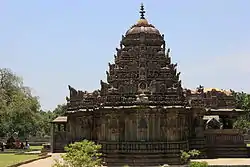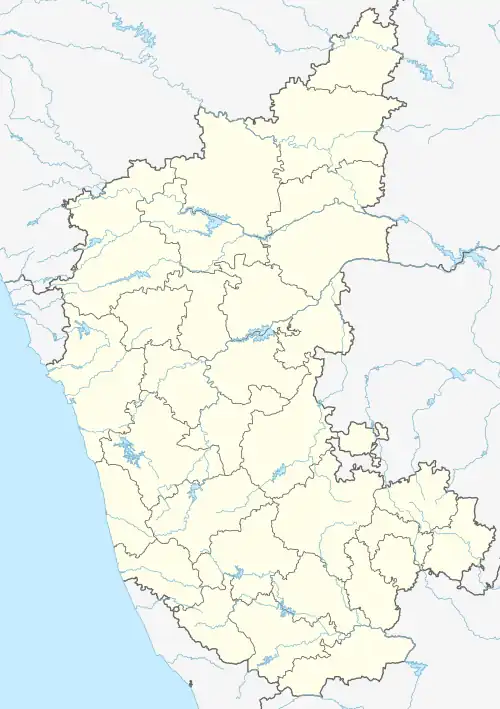Amrutesvara Temple, Amruthapura
The Amruteshvara temple also spelt "Amrutesvara" or "Amruteshwara", is located in the village of Amruthapura, 67 km north of Chikmagalur town in the Chikkamagaluru district of the Karnataka state, India. Located 110 km from Hassan and 50 km from Shimoga on NH 206, Amruthapura is known for the Amruteshvara temple. The temple was built in 1196 C.E. by Amrutheshwara Dandanayaka (lit, "commander") under Hoysala King Veera Ballala II.[1]
Amrutesvara Temple, Amruthapura | |
|---|---|
village | |
 Ekakuta (singly shrined), Amruteshvara temple, 1196, Chikkamagaluru district | |
 Amrutesvara Temple, Amruthapura Location in Karnataka, India | |
| Coordinates: 13.741°N 75.854°E | |
| Country | |
| State | Karnataka |
| District | Chikkamagaluru District |
| Languages | |
| • Official | Kannada |
| Time zone | UTC+5:30 (IST) |
Amrutesvara temple

_facing_the_sanctum_in_the_Amrutesvara_temple_at_Amruthapura.JPG.webp)
_of_Amrutesvara_temple_at_Amruthapura.jpg.webp)
_in_the_Amrutesvara_temple_at_Amruthapura.JPG.webp)
The temple is a built according to Hoysala architecture with a wide open mantapa (hall).[2] The temple has an original outer wall with unique equally spaced circular carvings. The temple has one vimana (shrine and tower) and therefore is a ekakuta design,[3] and has a closed mantapa (hall) that connects the sanctum to the large open mantapa.
It is medium-sized Hoysala temple with certain vastu features similar to the Veera Narayana Temple, Belavadi in mantapa structure and size. The open mantapa has twenty nine bays,[4] and the closed mantapa has nine bays with a side porch that leads to a separate shrine on the south side. The shrine is square in shape has the original superstructure (shikhara) which is adorned with sculptures of Kirtimukhas (demon faces), miniature decorative towers (aedicule). Below the superstructure, the usually seen panel of Hindu deities is absent. The base of the wall has five mouldings which according to art critic Foekema is an "older Hoysala style".[5] The sukanasi, the tower on top of the vestibule that connects the sanctum to the closed mantapa (the Sukanasi appears like the nose of the superstructure),[6] has the original Hoysala emblem of "Sala" fighting the lion.[7][8]
The rows of shining lathe turned pillars that support the ceiling of the mantapa is a Hoysala-Chalukya decorative idiom.[9] The mantapa has many deeply domed inner ceiling structures adorned with floral designs. The outer parapet wall of the open mantapa has a total of hundred and forty panel sculptures with depictions from the Hindu epics. Unlike many Hoysala temples where the panels are small and carvings in miniature, these panels are comparatively larger. The Ramayana is sculpted on the south side wall on seventy panels, with the story proceeding quite unusually, in anti-clockwise direction. On the north side wall, all depictions are clockwise, a norm in Hoysala architectural articulation. Twenty five panels depict the life of the Hindu god Krishna and the remaining forty five panels depict scenes from the epic Mahabharata.[9]
Ruvari Mallitamma, the well known sculptor and architect is known to have started his career here working on the domed ceilings in the main mantapa.[10]
The large stone inscription near the porch contains poems composed by medieval Kannada poet Janna who had the honorific Kavichakravarti (lit, "emperor among poets").[1]
Gallery
 Profile of shrine outer wall with Shikara (tower) at Amrutesvara temple, Amruthapura
Profile of shrine outer wall with Shikara (tower) at Amrutesvara temple, Amruthapura Close up of mantapa wall with miniature decorative towers, swirls and flourish in relief at Amrutesvara temple, Amruthapura
Close up of mantapa wall with miniature decorative towers, swirls and flourish in relief at Amrutesvara temple, Amruthapura Mantapa wall with miniature decorative towers (aedicule) in relief at Amrutesvara temple, Amruthapura
Mantapa wall with miniature decorative towers (aedicule) in relief at Amrutesvara temple, Amruthapura Wall relief at Amrutesvara temple, Amruthapura
Wall relief at Amrutesvara temple, Amruthapura Wall relief at Amrutesvara temple, Amruthapura
Wall relief at Amrutesvara temple, Amruthapura Close up of wall relief at Amrutesvara temple, Amruthapura
Close up of wall relief at Amrutesvara temple, Amruthapura Wall relief sculpture of the Amrutesvara temple
Wall relief sculpture of the Amrutesvara temple Wall relief sculpture at the Amrutesvara temple, Amruthapura
Wall relief sculpture at the Amrutesvara temple, Amruthapura Wall relief sculpture at Amrutesvara temple, Amruthapura
Wall relief sculpture at Amrutesvara temple, Amruthapura Wall relief sculpture at Amrutesvara temple, Amruthapura
Wall relief sculpture at Amrutesvara temple, Amruthapura Perforated window art at Amrutesvara temple, Amruthapura
Perforated window art at Amrutesvara temple, Amruthapura Hindu deity sculpture at Amrutesvara temple, Amruthapura
Hindu deity sculpture at Amrutesvara temple, Amruthapura Domical ceiling art at Amrutesvara temple, Amruthapura
Domical ceiling art at Amrutesvara temple, Amruthapura Domical ceiling art at Amrutesvara temple, Amruthapura
Domical ceiling art at Amrutesvara temple, Amruthapura Domical ceiling art at Amrutesvara temple, Amruthapura
Domical ceiling art at Amrutesvara temple, Amruthapura Wall relief sculpture, Amrutesvara temple
Wall relief sculpture, Amrutesvara temple Decorative swirls in bas-relief on mantapa outer wall at Amrutesvara temple, Amruthapura
Decorative swirls in bas-relief on mantapa outer wall at Amrutesvara temple, Amruthapura
Notes
- "Amritesvara Temple". Archaeological Survey of India, Bengaluru Circle. ASI Bengaluru Circle. Retrieved 26 July 2021.
- Foekema (1996), p37
- Quote:"Depending on the number of towers, temples are classified as ekakuta (one), dvikuta (two), trikuta (three), chatushkuta (four) and panchakuta (five). The last two types are rare. Sometimes a trikuta temple is literally not trikuta as only the central of three shrines may have a superstructure", Foekema (1996), p25
- Quote:"A bay is a square or rectangular compartment in the hall", Foekema (1996) p36, p93
- Quote:"In a typical "older style" that was popular throughout most of the 12th century Hoysala temples, there is one set of eaves where the tower meets the wall of the shrine. The eaves runs all around the temple. Eaves is a projecting roof overhanging the temple wall. Below the eaves are decorated miniature towers on pilasters. Below these towers are the wall panels of Hindu Gods, Goddesses and their attendants. Below these panels are the five mouldings", Foekema (1996), p28
- Foekema(1996), p22
- Foekema (1996), p22
- According to Kamath, Sala fights a tiger. According to historians such as C. Hayavadhana Rao, J. D. M. Derrett and B. R Joshi, "Sala" was the mythical founder of the empire, Kamath (2001), p123
- Quote:"a common feature of Western Chalukya-Hoysala temples", Kamath (2001), p117
- Architectural marvel by P.B.Premkumar, Spectrum, Tuesday, 20 January 2004 "Architectural marvel - Deccan Herald". Archived from the original on 30 May 2006. Retrieved 13 November 2006.